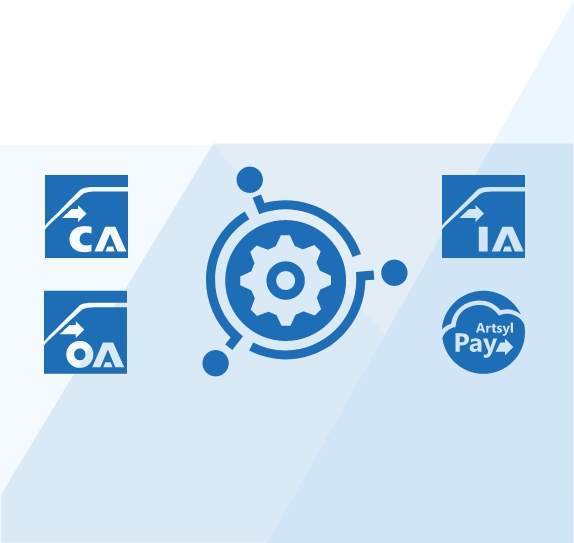The globalized business landscape makes companies constantly evaluate strategies to optimize their workforce and resources. Two prominent approaches that have gained significant traction are insourcing and outsourcing.
But with so much information swirling around insourcing vs outsourcing, it’s easy to get confused.
This article aims to clear the air. We’ll explain the core concepts of insourcing and outsourcing, highlighting the key differences between them. You will learn:
By understanding the advantages and disadvantages of each approach, you’ll be better equipped to make informed decisions for your business.

Ensure accuracy, speed, and compliance by leveraging our automated cross-checks and deep integration with your accounting systems.
What Is Insourcing
Insourcing is the practice of assigning a project or task to someone within the organization rather than hiring an external party to handle it. This approach leverages internal resources, employees, and expertise to complete work that might otherwise be outsourced.
By keeping tasks in-house, companies can maintain tighter control over processes and quality standards. This often leads to higher consistency and better alignment with company goals and standards.
Cost-Effectiveness of Insourcing
insourcing can save costs related to external vendor management, hidden fees, and quality issues that might arise from miscommunication. In addition, insourcing allows organizations to maximize the potential of their existing workforce. It can enhance employee skills, leading to a more versatile and capable team.
What’s important, sensitive projects, especially those involving proprietary information or confidential data, benefit from insourcing due to reduced risk of data breaches and information leaks. In-house teams can respond more quickly to changes and feedback compared to external vendors who may have other clients and priorities.
Challenges of Insourcing
Insourcing requires a significant investment in internal resources, including time, personnel, and potentially new technology or training. Internal teams might face capacity issues, especially if they are already handling a full workload. This can lead to delays and overburdened staff.
There may be higher initial costs related to training, technology investments, and the time required to build internal capabilities compared to outsourcing.
Examples of Insourcing
A company might choose to develop and manage its own IT infrastructure and support services internally instead of hiring an external IT firm.
Instead of contracting out manufacturing processes, a business may invest in its own production facilities and train employees to handle the manufacturing.
Organizations often build in-house marketing teams to create and execute campaigns, providing more direct control over branding and messaging.
What Are Core Competencies in Insourcing?
Core competencies are the unique strengths and abilities that a company possesses, which give it a competitive advantage in the market. These are usually related to key business functions or specialized knowledge that are central to the company’s operations and success. Insourcing often focuses on leveraging these core competencies internally to maintain control and quality.
Conversely, tasks that are not considered core competencies are more likely to be outsourced to specialists who can perform them more efficiently or at a lower cost.
As you can see, insourcing is a strategic choice that organizations make to utilize internal resources and maintain greater control over their operations. While it has its challenges, the benefits of improved quality, cost savings, and enhanced employee capabilities make it an attractive option for many businesses.
By carefully weighing the pros and cons, companies can determine when insourcing is the right approach for their needs.
Revolutionize your document management process with docAlpha. Our intelligent data capture and automation technology enhances your insourcing efficiency by converting all document types into actionable data swiftly and accurately.
Book a demo now
What Is Outsourcing?
Outsourcing refers to the business practice of contracting with an external provider to handle tasks or functions that would traditionally be done by in-house employees. Imagine delegating specific jobs to a specialist company, rather than having your own team handle them.
Here are some key characteristics of outsourcing. First of all, the work is done by a company outside your own organization. This means that outsourced tasks are typically performed by your own employees, but outsourcing is done to leverage the expertise of the external provider in a specific area. Many different types of tasks can be outsourced, ranging from basic administrative duties like data entry to complex projects like software development or manufacturing.
Outsourcing can be a cost-saving strategy. It can be a way to reduce labor costs or gain access to specialized skills without hiring full-time employees.
Why Vendor Management Is Important?
Vendor management refers to the processes and practices involved in managing and optimizing relationships with external service providers or suppliers. This includes selecting vendors, negotiating contracts, setting performance expectations, and monitoring and evaluating vendor performance.
Effective vendor management ensures that the outsourced services meet the company’s standards and requirements, contributing to overall operational efficiency. It also involves risk management and maintaining open communication channels to address any issues promptly.
The Role of the Service Level Agreement (SLA)
A Service Level Agreement (SLA) is a formal contract between a service provider and a client that outlines the expected level of service, performance metrics, and responsibilities of each party.
SLAs define the specific services to be provided, the standards for service delivery, and the penalties or remedies if the agreed-upon standards are not met. They are critical in outsourcing arrangements to ensure clarity and alignment of expectations between the client and the service provider. SLAs help manage performance, reduce risks, and provide a basis for evaluating the effectiveness of the outsourcing relationship.
Outsourcing and Quality Control: Choosing the Tasks Wisely
Here are some tasks that can be easily outsourced without compromising quality, if done correctly:
- Data Entry: Outsourcing companies specialize in accurate and efficient data entry, freeing up your in-house team for more strategic work.
- Bookkeeping & Payroll: Hiring a qualified accounting firm ensures financial accuracy and frees you from complex regulations.
- Customer Service (basic): Outsourcing basic customer service inquiries like order tracking or troubleshooting can improve response times and reduce costs.
- Graphic Design (non-core projects): For specialized design needs outside your brand identity, outsourcing can provide access to a wider talent pool.
- Content Creation (specific types): Outsourcing blog posts, social media content, or product descriptions can be efficient for specific content types, but ensure clear brand guidelines.
- Social Media Management (scheduling & monitoring): Outsourcing companies can schedule posts, monitor engagement, and provide basic analytics.
- Website Maintenance: Managed website hosting services can handle routine maintenance, security updates, and performance optimization.
- Software Development (specific projects): Outsourcing app development or specific software features can be efficient for projects outside your core expertise.
What Is Business Process Outsourcing?
Business Process Outsourcing (BPO) involves contracting out specific business processes, such as customer service, human resources, finance, or accounting, to third-party service providers.
BPO can be divided into front-office outsourcing, which includes customer-related services like contact centers, and back-office outsourcing, which includes internal business functions like billing and payroll.
The main objective of BPO is to improve efficiency, reduce costs, and allow the company to focus on its core business activities. BPO providers leverage economies of scale, specialized expertise, and advanced technologies to deliver services more efficiently than the company could in-house.
DISCOVER MORE: Boost Productivity: Smart Process Automation Hacks for Getting Ahead
Important Factors for Maintaining Quality in Outsourcing
Clear communication is key. Define project requirements, goals, and brand guidelines meticulously. To ensure quality control, establish a system for reviewing deliverables and ensuring they meet your standards. Choose reputable providers with strong security protocols to protect your confidential information.
By carefully selecting an outsourcing partner and establishing clear communication channels, you can ensure quality work without compromising your in-house team’s effectiveness.
Boost your order processing capabilities by insourcing with OrderAction. Achieve unparalleled accuracy and efficiency through advanced cross-checking against your price lists, contracts, and inventory levels. Simplify your supply chain management by optimizing order fulfillment internally.
Book a demo now
Insourcing vs Outsourcing: Key Differences
As we know, insourcing involves using internal resources and employees to complete tasks or projects within the organization. Outsourcing entails hiring external entities or individuals to handle tasks or projects that could be performed internally. But that’s not the only difference.
Control and Quality: Insourcing vs Outsourcing
Insourcing allows for greater control over processes, quality standards, and outcomes. It ensures consistency and alignment with the company’s goals and standards.
Outsourcing implies less direct control over the processes and quality as it relies on the external provider’s standards and expertise, which can vary.
Cost Comparison: Insourcing vs Outsourcing
Insourcing may involve higher initial costs for training, technology, and infrastructure. But it can be cost-effective in the long run by eliminating vendor fees and reducing quality issues.
Outsourcing is often perceived as cost-effective due to lower labor costs and reduced need for internal resources but can incur hidden costs such as management fees, contract renegotiations, and quality control.
LEARN MORE: Intelligent Process Automation and the Future for BPO
Resource Utilization: Insourcing vs Outsourcing
Insourcing utilizes the company’s existing workforce and infrastructure, as it enhances employee skills and versatility by involving them in a variety of tasks. Internal teams can quickly adapt to changes and feedback and therefore be more responsive to urgent needs and shifts in project scope. However, scaling up may require significant investment in hiring and infrastructure.
Outsourcing frees up internal resources to focus on core competencies and strategic initiatives. It provides access to specialized skills and technologies not available internally. Projects may face delays due to the external provider’s schedules and priorities. Contractual obligations can limit flexibility in making changes. However, outsourcing provides easy scalability by leveraging external resources.
Confidentiality and Security: Insourcing vs Outsourcing
Insourcing ensures a higher level of data security and confidentiality as tasks are handled within the organization. It reduces the risk of data breaches and information leaks.
Outsourcing may result in an increased risk of data breaches and confidentiality issues. It requires robust contracts and oversight to protect sensitive information.
The choice between insourcing and outsourcing depends on various factors including cost, control, resource availability, flexibility, and the nature of the tasks or projects.
- Insourcing offers greater control and security, leveraging internal talent and ensuring alignment with organizational goals.
- Outsourcing provides scalability, access to specialized skills, and potential cost savings but may come with challenges related to control, security, and quality.
Organizations must carefully assess their specific needs and capabilities to determine the most suitable approach.
Utilize the power of the docAlpha platform to create a unified and efficient insourcing strategy. docAlpha integrates seamlessly with your CRM, ERP, and other business systems, providing real-time data accuracy
and process automation.
Book a demo now
Insourcing on Steroids: How Intelligent Process Automation Makes It Shine
Traditionally, insourcing involves building your own team to handle tasks. While this offers control, it can be expensive and time-consuming. But what if you could leverage the benefits of insourcing while streamlining processes and cutting costs?
That’s where Intelligent Process Automation (IPA) tools like InvoiceAction, OrderAction, and docAlpha (part of the docAlpha suite) come in. Here’s how IPA tools supercharge your insourcing strategy:
Reduced Manual Effort: Imagine your team drowning in invoices, purchase orders, and other documents. IPA tools automate tedious tasks like data extraction, validation, and routing. This frees up your employees to focus on higher-value activities like strategic analysis or relationship building.
Improved Accuracy: Manual data entry is prone to errors. IPA tools utilize intelligent character recognition (ICR) and other technologies to ensure data accuracy from the get-go. This translates to fewer errors, rework, and delays, saving you time and money.
Faster Processing: Paperwork can clog up your workflow. IPA tools automate document processing, significantly reducing turnaround times. Get invoices approved faster, streamline order fulfillment, and keep your business moving.
Enhanced Visibility: Struggling with siloed data and a lack of transparency? IPA tools provide real-time insights into your processes. Track progress, identify bottlenecks, and make data-driven decisions to further optimize your workflow.
Scalability: Business needs can fluctuate. IPA tools offer a scalable solution. You can easily adapt the technology to handle an increased workload without needing to significantly expand your team.
Let’s take a specific example: InvoiceAction. Imagine your finance team bogged down in manual invoice processing. InvoiceAction automates the entire process, from capturing invoice data to routing it for approval. This saves hours, reduces errors, and ensures invoices are paid on time, potentially leading to early payment discounts.
Intelligent Process Automation tools empower you to achieve the best of both worlds with insourcing. You retain control over your processes while significantly improving efficiency and cost-effectiveness. With a streamlined workflow and reduced workload, your in-house team can focus on what they do best – driving strategic growth for your business.
READ NEXT: Outsourcing Vs. Automating — A Business Decision
Final Thoughts: Choosing Between Insourcing vs Outsourcing
So, which approach is right for you — insourcing or outsourcing? The answer ultimately depends on your specific needs and goals. Carefully consider factors like project complexity, budget constraints, expertise availability, and desired level of control.
Don’t be afraid to experiment! A hybrid approach that combines both insourcing and outsourcing can be the sweet spot for many businesses. By leveraging the strengths of both strategies, you can create a dynamic and efficient workforce that propels your company toward success.
Take control of your business processes with docAlpha. Improve your insourcing strategy and gain a competitive edge by managing your critical tasks in-house with precision and reliability.
Book a demo now




 10 Benefits of Process Automation
10 Benefits of Process Automation Automation Tools for Microsoft 365
Automation Tools for Microsoft 365 Explanation of Benefits (EOB)
Explanation of Benefits (EOB) Accounts Payable Payment Terms
Accounts Payable Payment Terms Document Classification: Why Is It Important?
Document Classification: Why Is It Important? Opportunity Cost Explained
Opportunity Cost Explained